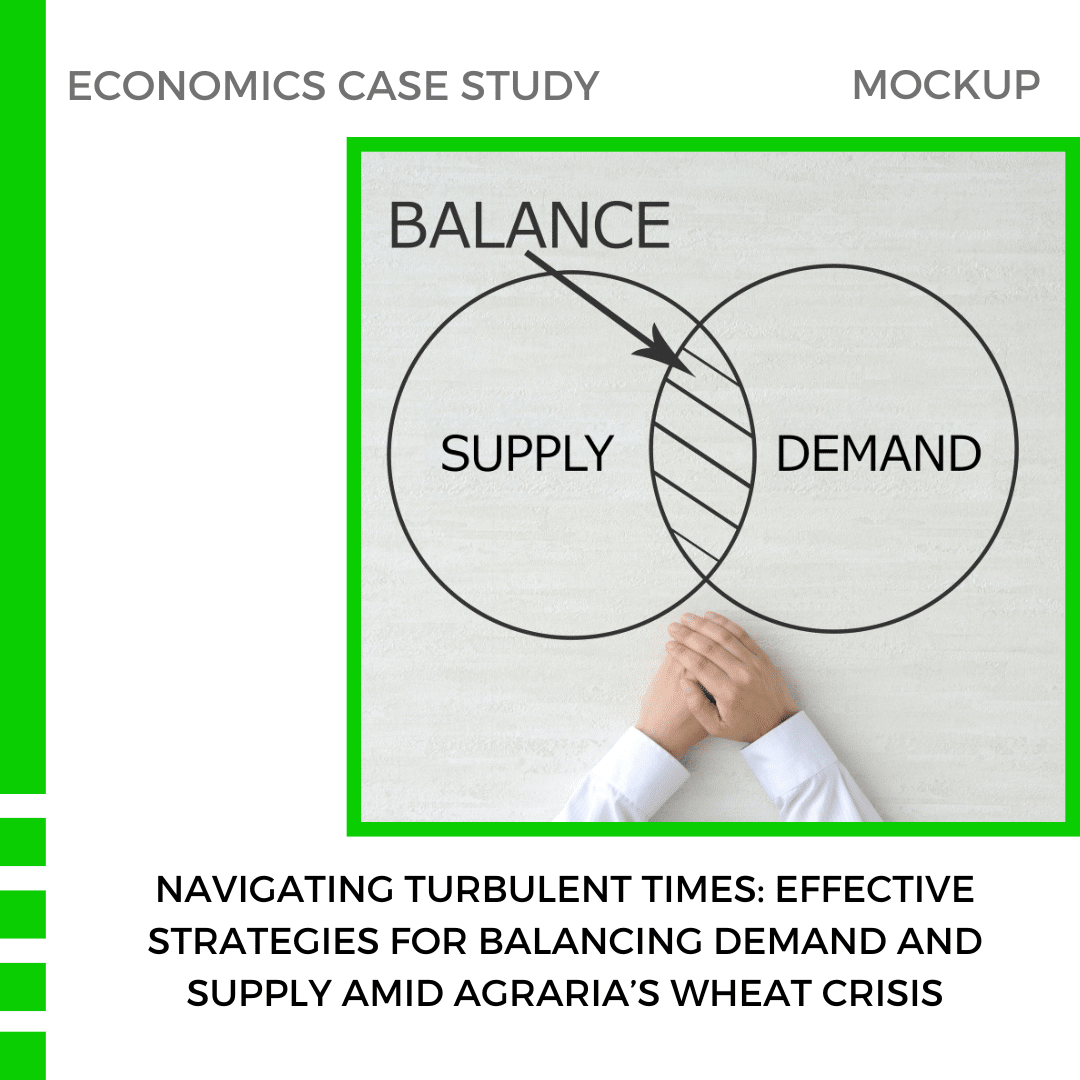
Navigating Turbulent Times: Effective Strategies for Balancing Demand and Supply Amid Agraria’s Wheat Crisis
Introduction
This case study examines the serious challenge faced by Agraria, a developing nation heavily reliant on wheat for food security and economic stability. Agraria is currently grappling with the complexities of balancing demand and supply due to a severe wheat shortage caused by unpredictable weather events. Climate change has disrupted the nation’s previously stable weather patterns, resulting in unexpected droughts, unseasonal rains, and intense storms. These conditions have caused wheat production to fall by 40%, triggering a supply shortage that has fueled food inflation and threatened the livelihoods of farmers and low-income households.
The study offers a detailed analysis of the balancing demand and supply dilemma confronting Agraria. It highlights how disrupted supply chains, insufficient government intervention, and strained financial management further complicate the situation. Students will assess the immediate impacts—such as inflation and food insecurity—and long-term consequences, including potential damage to Agraria’s economic stability and social welfare. They will also explore essential strategies to address the crisis, such as farmer support programs, price management policies, and crop diversification initiatives to build resilience and reduce future risks.
This real-world scenario provides a valuable opportunity for students to examine how balancing demand and supply becomes particularly challenging during agricultural crises. They will explore how government policies can mitigate the impacts of supply disruptions and stabilize prices, and they will analyze how financial strategies help manage inflation and protect vulnerable populations. Notably, the case underscores the significance of proactive planning and sustainable agricultural practices to minimize the impact of unpredictable weather events.
By working on this case, students will better understand that balancing demand and supply requires more than short-term solutions. Critical elements include adaptive planning, proactive government intervention, and strong collaboration across sectors. They will also learn that efforts to maintain economic growth, protect social welfare, and safeguard the environment must align to achieve effective outcomes.
The ability to effectively manage balancing demand and supply during times of uncertainty is crucial for national resilience. Through this exercise, students will strengthen their analytical thinking and problem-solving skills. They will appreciate how governments must carefully navigate agricultural risks while pursuing long-term sustainability and societal well-being. Ultimately, this case study aims to provide insights into how nations can overcome agricultural crises by balancing demand and supply across competing priorities—economic growth, social stability, and environmental sustainability.
Background of Agraria
Overview of Agraria
Agraria is an agriculturally dependent developing country where wheat is a staple crop and a vital part of the economy. With most citizens relying on wheat-based foods, disruptions in the wheat supply have a direct impact on public welfare. Agriculture employs a significant portion of the population, making it a critical economic driver and a livelihood source for millions.
Historical Weather Patterns
While Agraria has traditionally enjoyed stable weather conducive to farming, recent years have seen growing climate variability. The rising frequency of droughts and unseasonal weather events has created new challenges for agricultural productivity.
Key Events Leading to the Wheat Shortage
Adverse Weather Conditions
Over the past year, prolonged droughts during key growing periods, followed by sudden storms, caused significant damage to wheat crops. This climate shift resulted in one of the lowest harvests in decades.
Reduced Harvest
The wheat harvest fell by 40% from the annual average, creating a supply shortfall and disrupting balancing demand and supply in the market.
Rising Prices and Inflation
The scarcity of wheat led to soaring prices, causing food inflation that hit the population—particularly vulnerable communities—hard.
Immediate Impact on Agraria
Food Security Concerns
The supply shortage disrupted balancing demand and supply for essential food items, leaving many families unable to afford basic staples. This has increased the risk of malnutrition and hunger, especially in low-income areas.
Economic Strain
Agraria’s agriculture-dependent economy has suffered a significant blow. Reduced wheat output has caused farmers to lose income, while production costs have increased for food manufacturers and businesses relying on grain.
Social Unrest
The economic strain and food shortages have triggered protests and demands for government action, leading to political challenges.
Strategic Challenges
- Importing Wheat
Agraria must import wheat to meet immediate demand. However, securing reliable suppliers and managing the financial impact of imports are significant hurdles. - Supporting Farmers
Financial relief, subsidies, and training on sustainable farming practices are essential for long-term recovery. - Managing Food Prices
Government price controls and subsidies are necessary to stabilize food prices and protect consumers from inflation. - Crop Diversification
Encouraging the cultivation of alternative crops will reduce Agraria’s dependence on wheat and help balance demand and supply during future disruptions.
Tasks for Students
- Task 1: Impact Analysis – Evaluate the wheat shortage’s economic, social, and environmental impacts on Agraria.
- Task 2: Import Strategy – Develop an import strategy to address the immediate wheat shortage. Identify reliable suppliers and manage the costs involved.
- Task 3: Farmer Support Plan – Propose measures to support farmers, including financial aid, subsidies, and training programs.
- Task 4: Price Stabilization Measures – Suggest ways to stabilize food prices through subsidies and social safety nets.
- Task 5: Crop Diversification Strategy – Create a plan to encourage the cultivation of resilient crops suitable for Agraria’s changing climate.
- Task 6: Risk Management Plan – Design a plan to enhance Agraria’s resilience to future agricultural crises.
Possible Solution
Agraria can overcome this crisis through a combination of short-term and long-term strategies.
- Short-Term: Secure wheat imports from reliable international suppliers to meet immediate needs. Implement temporary subsidies to stabilize food prices and protect consumers.
- Long-Term: Invest in agricultural infrastructure, provide training on sustainable farming practices, and promote crop diversification. Establish a national grain reserve to prevent future shortages. Strengthening partnerships with global organizations can also improve Agraria’s resilience.
Conclusion
The wheat shortage in Agraria highlights the intricate task of balancing demand and supply within the agricultural sector, particularly under the strain of climate change. This crisis exposes the vulnerability of over-reliance on a single crop, stressing the need to develop resilient farming systems. Achieving balancing demand and supply during such disruptions requires more than immediate fixes—it demands short-term interventions and sustainable long-term planning. For Agraria, recovery involves importing wheat to meet urgent needs, investing in sustainable agricultural practices, and strategically diversifying crops to reduce future risks.
Balancing demand and supply is also critical for supporting farmers during difficult times. Financial assistance, infrastructure improvements, and training on resilient farming techniques can help stabilize the agricultural sector. Simultaneously, managing food prices is essential to prevent inflation, protect vulnerable communities, and maintain economic stability. Without thoughtful strategies, agriculture risks food insecurity, social unrest, and long-term economic setbacks.
This case study allows students to engage with practical solutions for balancing demand and supply in the face of agricultural uncertainty. They will explore key strategies such as government intervention, risk management, and crop diversification to tackle complex crises. Through this process, students learn how policies and proactive planning are necessary to prevent future disruptions and ensure food security.
Learning from Agraria’s experience allows students to apply their knowledge to real-world scenarios where balancing demand and supply is a critical challenge. It emphasizes the importance of adaptability, forward-thinking policies, and collaborative efforts between the government, farmers, and the private sector. By working through this case, students will develop the skills to address future agricultural and economic challenges, preparing them to take action when nations face disruptions in balancing demand and supply.
Students can explore the official websites of the Food and Agriculture Organization (FAO) and World Bank for further resources on agricultural strategies and food security.
Explore Business Models of Global Companies and Indian Companies
Tag:agricultural crisis, Balancing Demand and Suppl, balancing demand and supply, case studies, case study, climate change and agriculture, crop diversification, Economic Stability, economics case study, farmer support programs, food security, mockup case study, sustainable farming practices, wheat price inflation, wheat shortage



